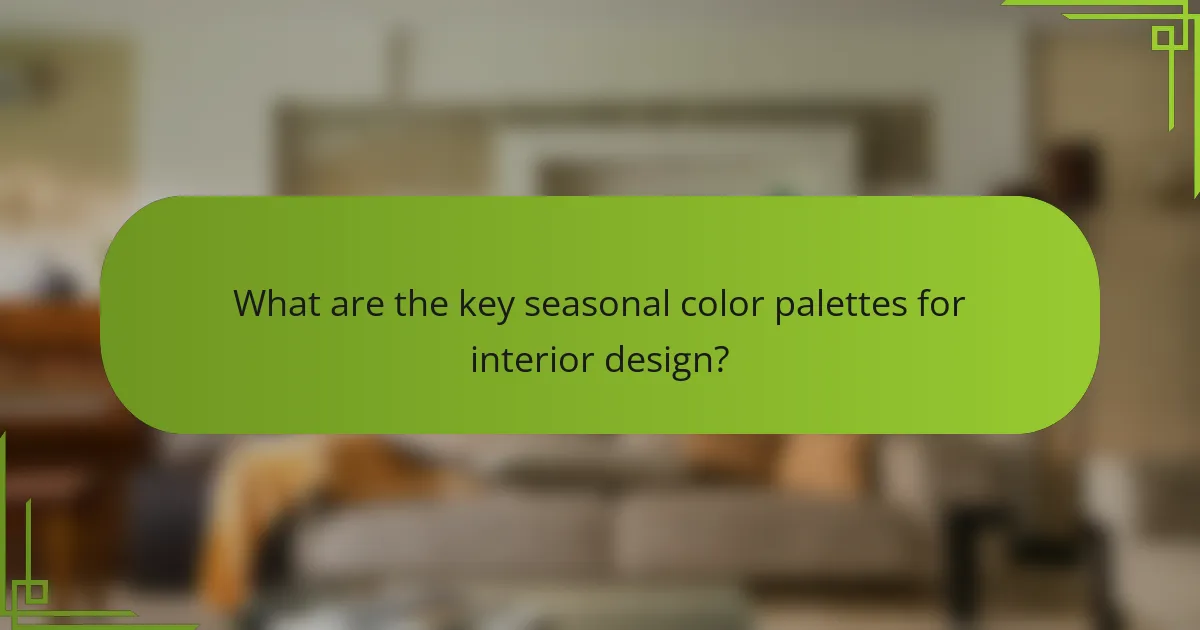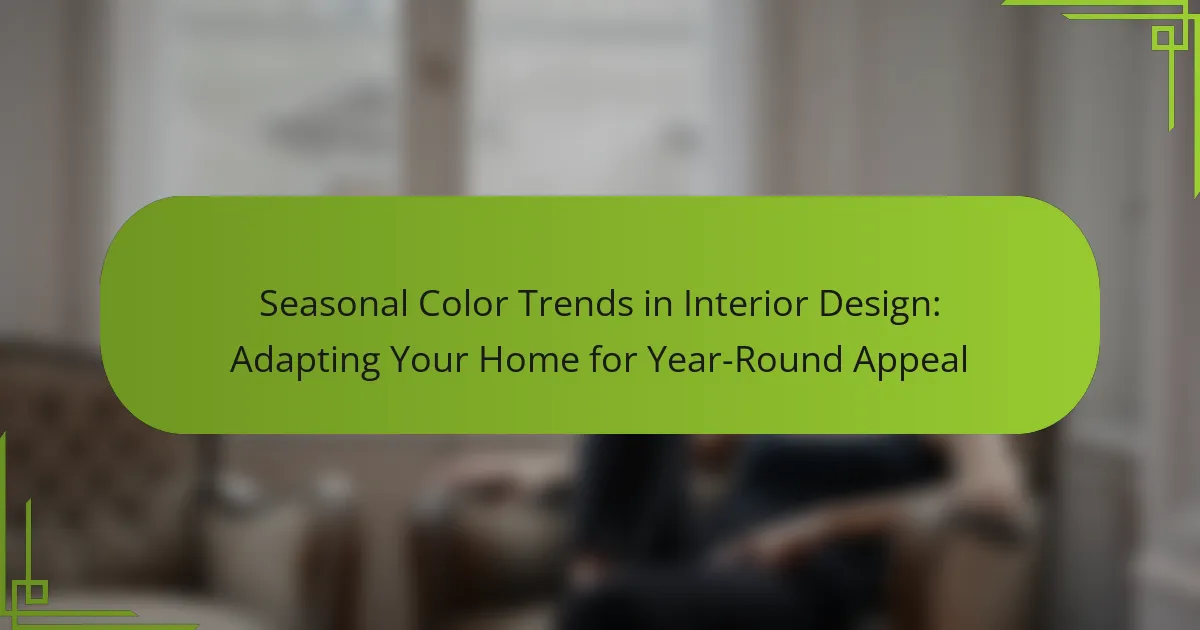
What are Seasonal Color Trends in Interior Design?
Seasonal color trends in interior design refer to the shifting palettes that reflect the characteristics of each season. These trends influence the choice of colors used in home decor and furnishings. For example, spring often features soft pastels like light pinks and greens. Summer typically embraces vibrant hues such as bright yellows and blues. Autumn tends to highlight warm, earthy tones like oranges and browns. Winter often favors cool colors, including deep blues and grays. Designers and homeowners adapt these trends to create inviting spaces that resonate with the seasonal atmosphere. The cyclical nature of these trends is evident in annual design forecasts and industry reports.
How do seasonal color trends influence interior design choices?
Seasonal color trends significantly influence interior design choices by dictating the palette that designers and homeowners select. Each season brings a unique set of colors that reflect nature and cultural moods. For example, spring often features pastel shades like soft pinks and greens, while autumn tends to embrace warm tones such as burnt orange and deep red.
These color trends guide designers in creating cohesive and appealing spaces. Research indicates that color can affect mood and perception, making it crucial for designers to align their choices with seasonal aesthetics. According to the Pantone Color Institute, colors resonate with consumers, impacting their purchasing decisions and preferences in home decor.
Incorporating seasonal colors can rejuvenate a space, making it feel fresh and inviting. Designers often recommend changing accent pieces, such as cushions or wall art, to reflect these trends. This adaptability allows homeowners to keep their interiors aligned with the current season’s vibe.
What psychological effects do colors have on mood and space?
Colors significantly influence mood and perception of space. For instance, warm colors like red and orange can evoke feelings of warmth and excitement. They often stimulate energy and can create a sense of intimacy. In contrast, cool colors such as blue and green tend to have calming effects. These colors are associated with tranquility and can make spaces feel larger and more open. Studies show that color can affect physiological responses, such as heart rate and blood pressure. For example, a study published in the Journal of Environmental Psychology found that blue environments can reduce stress levels. Additionally, color can impact productivity and creativity in workspaces. Bright colors may enhance enthusiasm, while muted tones can promote focus. Therefore, understanding color psychology is essential for effective interior design.
How do cultural factors shape seasonal color preferences?
Cultural factors significantly influence seasonal color preferences. Different cultures associate specific colors with various meanings and emotions. For example, in Western cultures, spring often brings pastel colors symbolizing renewal. In contrast, Eastern cultures may favor bright reds and golds during the same season, representing prosperity and happiness.
Regional climates also play a role in these preferences. In warmer climates, vibrant colors are more prevalent, reflecting the natural environment. Conversely, cooler regions may lean towards muted tones that harmonize with their surroundings. Historical events and traditions further shape these preferences. For instance, festivals and holidays often dictate color choices, such as the use of green for St. Patrick’s Day in the U.S.
Additionally, fashion trends can impact interior design color choices. As designers introduce new palettes, cultural influences can shift consumer preferences seasonally. This interplay demonstrates how cultural contexts create diverse seasonal color preferences across different regions and communities.
Why is it important to adapt your home’s colors seasonally?
Adapting your home’s colors seasonally is important for enhancing aesthetic appeal. Seasonal colors align with nature’s changes, creating a harmonious environment. This practice can boost mood and well-being. For instance, warm tones in fall evoke comfort, while cool colors in summer promote relaxation. Seasonal color changes also keep the home feeling fresh and inviting. Regular updates can increase the home’s value. A study by the National Association of Realtors indicates that well-decorated homes attract more buyers and can sell for higher prices.
What benefits does seasonal color adaptation provide for homeowners?
Seasonal color adaptation provides homeowners with aesthetic enhancement and emotional well-being. It allows for a refreshed look that aligns with changing seasons. This practice can increase the appeal of a home to potential buyers. Research shows that homes with seasonal updates can sell faster. Additionally, adapting colors can improve mood and create a welcoming atmosphere. Studies indicate that color influences emotions and perceptions. Seasonal changes can also reflect personal style and creativity. This adaptability fosters a connection between the home and its environment.
How can seasonal colors enhance the aesthetic of a space?
Seasonal colors can enhance the aesthetic of a space by creating a harmonious and inviting atmosphere. They reflect the changing moods and natural beauty of each season. For example, warm tones like oranges and browns evoke the coziness of autumn. In contrast, cool colors such as blues and greens can bring a refreshing feel during summer. Seasonal colors can also influence how light interacts with a room. Bright colors can make spaces feel larger and more open, while darker hues can add intimacy. According to color psychology, different colors can affect emotions and perceptions. This impact can lead to a more enjoyable living environment. Thus, incorporating seasonal colors can significantly elevate the overall aesthetic appeal of a space.

What are the key seasonal color palettes for interior design?
Key seasonal color palettes for interior design include spring pastels, summer brights, autumn earth tones, and winter neutrals. Spring palettes often feature soft hues like blush pink, mint green, and lavender. Summer color schemes include vibrant shades such as turquoise, sunny yellow, and coral. Autumn palettes are characterized by rich colors like burnt orange, deep red, and golden yellow. Winter color schemes typically focus on cool tones like icy blue, crisp white, and deep navy. These palettes reflect the changing seasons and enhance the mood of interior spaces.
What colors are popular in spring interior design?
Pastel colors are popular in spring interior design. Soft shades like mint green, blush pink, and light lavender create a fresh atmosphere. These colors reflect the blooming nature of spring. Bright yellows and sky blues also gain popularity during this season. They evoke feelings of warmth and optimism. According to design experts, these colors enhance natural light in spaces. Incorporating these hues can rejuvenate a room’s ambiance. Spring palettes often include floral patterns that complement these colors.
How can pastel shades be incorporated into spring decor?
Pastel shades can be incorporated into spring decor through various methods. Soft hues like mint green, blush pink, and lavender can be used on walls or furniture. These colors create a light and airy atmosphere that reflects the season’s renewal. Incorporating pastel-colored throw pillows and blankets adds a cozy touch. Floral arrangements featuring pastel blooms enhance the spring theme. Using pastel tableware for spring gatherings can elevate the dining experience. Additionally, pastel artwork or wall hangings can serve as focal points in a room. These elements collectively contribute to a refreshed spring ambiance in any space.
Which accent colors complement spring palettes effectively?
Accent colors that complement spring palettes effectively include soft pastels and vibrant hues. Colors like blush pink, mint green, and lavender create a fresh atmosphere. Additionally, sunny yellows and light blues enhance the spring aesthetic. These colors evoke feelings of renewal and warmth. Research shows that pastel tones are particularly popular in spring design trends. The use of these colors can brighten spaces and promote a sense of tranquility. They work well with neutral base colors, creating a balanced look. This combination is widely used in interior design during the spring season.
What colors dominate summer interior design trends?
Bright and vibrant colors dominate summer interior design trends. Shades like coral, turquoise, and sunny yellows are popular. These colors evoke a sense of warmth and energy. Additionally, soft pastels like mint green and blush pink are also trending. These hues create a refreshing and airy atmosphere. According to the 2023 Color Trends Report by Pantone, these colors enhance the feeling of summer indoors. They reflect the natural brightness of the season. This combination of bold and soft colors creates a balanced and inviting space.
How can vibrant colors be used to create a lively summer atmosphere?
Vibrant colors can create a lively summer atmosphere by infusing spaces with energy and warmth. Bright hues like yellow, turquoise, and coral evoke feelings of joy and relaxation. These colors reflect the vibrancy of summer landscapes, enhancing mood and engagement. Incorporating these shades through decor, textiles, and wall paint can transform a room. For instance, a sunny yellow accent wall can make a space feel more open and inviting. Additionally, colorful accessories like cushions and artwork can add playful touches. Research shows that color can influence emotions; warm colors often increase feelings of happiness. Thus, using vibrant colors effectively contributes to a cheerful summer ambiance.
What are the best ways to balance bold summer colors with neutrals?
To balance bold summer colors with neutrals, use a 70-30 ratio. This means that 70% of the space should be neutral tones. Use bold colors as accents in smaller areas like cushions or artwork. Choose neutral furniture to ground the bright colors. Incorporate textures in neutrals to add depth. Use natural materials like wood or stone for a cohesive look. This approach allows bold colors to stand out without overwhelming the space. Research shows that balanced color schemes create a harmonious environment.
What are the autumn color trends in interior design?
Autumn color trends in interior design include warm hues like deep oranges, rich browns, and muted greens. These colors evoke a sense of coziness and connection to nature. Earthy tones such as terracotta and mustard yellow are also popular. They complement the seasonal shift and create inviting spaces. Jewel tones like burgundy and navy add a touch of elegance. Textured fabrics in these colors enhance the overall aesthetic. According to design experts, these trends reflect the changing landscape during autumn. Incorporating these colors can transform a space into a seasonal retreat.
How do warm tones influence the feel of autumn spaces?
Warm tones create a cozy and inviting atmosphere in autumn spaces. These colors, such as reds, oranges, and yellows, evoke feelings of warmth and comfort. Warm tones are associated with the changing leaves and the essence of the season. They can enhance the emotional connection to autumn, making spaces feel more intimate. Research shows that colors can impact mood and perception. A study published in the Journal of Environmental Psychology indicates that warm colors can increase feelings of comfort and relaxation. Therefore, incorporating warm tones in autumn decor effectively enhances the seasonal ambiance.
Which textures enhance the autumn color palette?
Textures that enhance the autumn color palette include rich fabrics like velvet and wool. These materials add warmth and depth to the color scheme. Natural elements such as wood and stone also complement autumn hues. They provide an organic feel that resonates with the season. Textured finishes like matte and brushed surfaces can enhance visual interest. Incorporating these textures creates a cozy atmosphere that reflects autumn’s essence. The combination of these textures works harmoniously with warm tones like burnt orange and deep reds. This approach aligns with current interior design trends focusing on seasonal adaptability.
What winter color trends should be considered for interior design?
Winter color trends for interior design include deep blues, rich greens, and warm neutrals. These colors create a cozy atmosphere during the colder months. Deep blues evoke a sense of tranquility and pair well with natural wood elements. Rich greens bring the outdoors inside, promoting a refreshing vibe. Warm neutrals, like taupe and beige, provide a comforting backdrop for winter decor. According to Pantone’s Color of the Year, these hues align with current trends, reflecting a desire for comfort and connection to nature.
How can cool tones create a cozy winter environment?
Cool tones can create a cozy winter environment by promoting a sense of calm and tranquility. Shades like soft blues, greens, and grays mimic the serene qualities of winter landscapes. These colors can enhance natural light, making spaces feel airy yet warm. Cool tones also evoke feelings of comfort and relaxation, essential for cozy winter settings. Research indicates that color psychology supports the calming effects of cool tones on mood. For example, a study published in the Journal of Environmental Psychology shows that cool colors can lower stress levels. This makes them ideal for creating inviting spaces during the colder months.
What are the best practices for using metallics in winter decor?
Use metallics sparingly in winter decor to enhance elegance without overwhelming the space. Choose a limited color palette that includes gold, silver, or copper for a cohesive look. Incorporate metallic accents through decorative items like vases, candle holders, or picture frames. Layer metallics with natural elements such as wood or greenery for balance. Use metallic textiles, like cushions or throws, to add warmth and texture. Ensure proper lighting to highlight metallic finishes, creating a warm ambiance. Consider the scale of metallic pieces to maintain harmony in the overall decor. Select metallics that complement your existing color scheme for a unified aesthetic.

How can you successfully adapt your home for year-round appeal?
To successfully adapt your home for year-round appeal, incorporate versatile design elements. Use neutral color palettes as a foundation. This allows for easy seasonal updates. Add accent colors that can be changed with decor. Utilize interchangeable textiles like throw pillows and blankets. Choose furniture with timeless designs to ensure longevity. Incorporate plants that thrive in various seasons for a fresh look. Ensure adequate lighting to create a warm ambiance throughout the year. Regularly refresh artwork and accessories to keep the space dynamic and engaging.
What strategies can be used for seamless seasonal transitions?
To achieve seamless seasonal transitions in interior design, consider using a neutral color palette as a base. This approach allows for easy integration of seasonal accents. Incorporate textiles like throw pillows and blankets that can be swapped out with the seasons. Use natural elements, such as plants and flowers, to add freshness throughout the year. Implement layered lighting to create different atmospheres as seasons change. Rotate artwork and decorative items to reflect seasonal themes. Maintain flexibility in furniture arrangement to adapt to seasonal activities. These strategies ensure your home remains inviting and stylish year-round.
How can accessories be utilized to reflect seasonal changes?
Accessories can be utilized to reflect seasonal changes by incorporating colors, materials, and designs that align with each season. For example, in spring, bright pastels and floral patterns can be used in cushions and throws. Summer can be represented with vibrant colors and lightweight fabrics, such as linen or cotton. In autumn, earthy tones and textures like wool or knitted items can create a cozy atmosphere. Winter accessories can include rich jewel tones and luxurious materials like velvet to evoke warmth. Seasonal changes can also be reflected through decorative items, such as seasonal artwork or themed ornaments. This approach not only enhances the aesthetic appeal but also creates a harmonious environment that resonates with the time of year.
What role do paint and wall treatments play in seasonal adaptation?
Paint and wall treatments play a significant role in seasonal adaptation by influencing the aesthetic and emotional atmosphere of a space. They allow homeowners to reflect seasonal changes through color and texture. For example, warm tones can create a cozy environment in winter, while cool colors can evoke freshness in summer. Additionally, wall treatments like wallpapers or textures can add depth and interest, aligning with seasonal themes. Research shows that color psychology impacts mood, making it essential to choose appropriate hues for each season. Adapting paint and wall treatments can enhance comfort and visual appeal throughout the year.
How can you maintain a cohesive look while adapting colors?
To maintain a cohesive look while adapting colors, use a consistent color palette. Choose a base color to anchor the design. Incorporate complementary colors that enhance the base without overwhelming it. Limit the number of colors to three or four for simplicity. Use shades and tints of the chosen colors to create depth and variation. Ensure that the colors align with the overall theme of the space. This approach helps achieve harmony across different elements in the interior. Consistency in color usage fosters a unified aesthetic throughout the home.
What are the principles of color theory that aid in design cohesion?
The principles of color theory that aid in design cohesion include color harmony, contrast, and the color wheel. Color harmony refers to the pleasing arrangement of colors that create a sense of balance. It is essential for achieving a cohesive look in design. Contrast involves using differing colors to highlight elements and create visual interest. This principle helps to prevent monotony in color schemes. The color wheel serves as a tool to understand relationships between colors, such as complementary and analogous colors. Complementary colors are opposite each other on the wheel and create vibrant contrasts. Analogous colors are next to each other on the wheel and provide a more serene and cohesive palette. Understanding these principles enables designers to create spaces that feel unified and aesthetically pleasing.
How can contrasting colors be balanced for a harmonious space?
Contrasting colors can be balanced for a harmonious space by using a neutral base. Neutrals help to unify bold colors and create a cohesive look. Incorporating varying shades of the contrasting colors adds depth without overwhelming the space. For example, pairing a bright blue with softer blue tones can create balance. Additionally, using patterns that combine both contrasting colors can also harmonize the overall design. Color blocking techniques can effectively define areas while maintaining a sense of unity. Finally, strategic placement of accessories in contrasting colors can enhance the overall balance. These methods are supported by color theory principles, which emphasize harmony through contrast.
What practical tips can help you implement seasonal color trends?
To implement seasonal color trends, start by selecting a color palette that reflects the current season. For spring, consider soft pastels; for summer, vibrant hues; for autumn, warm earth tones; and for winter, deep jewel tones. Incorporate these colors through paint, decor, and furnishings. Use accessories like cushions, throws, and artwork to easily switch colors. Consider the natural light in your space, as it affects how colors appear. Test colors in small areas before making large changes. Seasonal color trends can enhance mood and create a fresh ambiance in your home.
How can you create a seasonal color rotation plan for your home?
To create a seasonal color rotation plan for your home, start by selecting a color palette for each season. Choose warm tones like reds and oranges for fall, cool blues and whites for winter, fresh greens and pastels for spring, and vibrant yellows and blues for summer. Next, identify key areas in your home to apply these colors, such as walls, accessories, and textiles.
Plan to rotate these colors every three months to align with the seasons. Use removable decor items like cushions, throws, and artwork for easy updates. Consider using paint samples or swatches to visualize how colors interact in your space.
Research shows that color can significantly impact mood and ambiance, making it essential to choose colors that reflect seasonal changes. Studies indicate that seasonal color changes can enhance the overall aesthetic of a home and improve residents’ well-being.
What common mistakes should be avoided when changing seasonal colors?
One common mistake to avoid when changing seasonal colors is not considering the overall color palette. A cohesive palette ensures harmony throughout the space. Another mistake is neglecting the impact of lighting on color perception. Natural and artificial light can alter how colors appear. Failing to test colors in the actual space is also a frequent error. Paint samples should be viewed at different times of day. Additionally, over-accessorizing with seasonal colors can overwhelm a room. It is essential to balance bold colors with neutral tones. Lastly, ignoring personal style can lead to dissatisfaction. Seasonal changes should reflect individual preferences while adapting to trends.
Seasonal color trends in interior design are the evolving color palettes that correspond to each season, influencing home decor choices. The article explores how these trends affect mood, perception, and cultural preferences, highlighting key color palettes for spring, summer, autumn, and winter. It discusses the psychological effects of color, the importance of seasonal adaptations for aesthetic appeal and emotional well-being, and practical strategies for implementing these trends in home design. Additionally, it addresses common mistakes to avoid when changing seasonal colors, ensuring a cohesive and inviting environment year-round.
